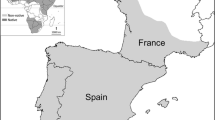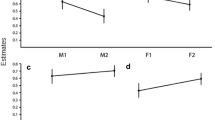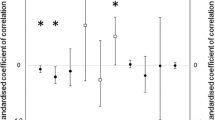Abstract
The least weaselMustela nivalis nivalis Linnaeus, 1766 is unique among carnivores because of its small body size and capacity for fast reproduction. It has been suggested to be the main agent for maintaining cyclic fluctuations in northern vole populations, largely based on its high reproductive potential and dependence on small rodents. This study describes basic reproductive data on the least weasel obtained during a captive breeding program. In the experiments, food availability was manipulated at the onset of breeding. Altogether, 65 litters were born during the 5-year study. The mean litter size was 5.1 (in 53 litters of known litter size), the most common litter size being six. The sex ratio of weaned young was not biased from 1∶1. The median date of birth was June 4. Food manipulations did not affect mating frequency suggesting that the observation of failure in breeding in years of low abundance of small mammals is due to mortality of embryos or young before weaning, but not due to avoidance of breeding at low food availability. In this respect, weasels differ from other main vole predators, owls and raptors, which often skip breeding if small mammals are scarce.
Similar content being viewed by others
References
Blomquist L., Muuronen P. and Rantanen V. 1981. Breeding the least weasel in Helsinki Zoo. Zoologische Garten N. F., Jena 51: 363–368.
Collett R. 1911–1912. [Mammals of Norway]. Aschehoug & Co, Christiania: 1–744. [In Norwegian]
Danilov P. I. and Tumanov I. L. 1980. Female reproductive cycles in the Mustelidae. [In: Biology of mustelids: some Soviet research. Vol. 2. C. M. King, ed]. New Zealand Department of Scientific and Industrial Research, Wellington: 81–93.
Deanesly R. 1944. The reproductive cycle of the female weasel (Mustela nivalis). Proceedings of the Zoological Society of London 114: 339–349.
East K. and Lockie J. D. 1964. Observations on a family of weasels (Mustela nivalis) bred in captivity. Proceedings of the Zoological Society of London 143: 359–363.
East K. and Lockie J. D. 1965. Further observations on weasels (Mustela nivalis) and stoats (Mustela erminea) born in captivity. Journal of Zoology, London 147: 234–238.
Erlinge S. 1974. Distribution, territoriality and numbers of the weaselMustela nivalis in relation to prey abundance. Oikos 25: 308–314.
Fitzgerald B. M. 1981. Predatory birds and mammals. [In: Tundra ecosystems: a comparative analysis. L. C. Bliss, J. B. Cragg, D. W. Hea and J. J. Moore, eds]. Cambridge University Press, Cambridge: 485–508.
Frank F. 1974. Wurfzahlund Wurffolge beim nordischen Wiesel. Zeitschrift für Säugertierkunde 39: 248–250.
Hall E. R. 1951. American weasels. University of Kansas, Publications of the Museum of Natural History 4: 1–466.
Hanski I., Henttonen H. and Hansson L. 1991. Specialist predators, generalist predators, and the microtine rodent cycle. Journal of Animal Ecology 60: 353–367.
Hanski I., Henttonen H., Korpimäki E., Oksanen L. and Turchin P. 2001. Small rodent dynamics and predation. Ecology 82: 1505–1520.
Hansson L. 1984. Winter reproduction of small mammals in relation to food conditions and population dynamics. [In: Winter ecology of small mammals. J. F. Merritt, ed]. Special Publication of Carnegie Museum of Natural History, Pittsburgh 10: 225–234.
Hansson L. and Henttonen H. 1985. Gradients in density variations of small rodents: the importance of latitude and snow cover. Oecologia 67: 394–402.
Hansson L. and Henttonen H. 1988. Rodent dynamics as community processes. Trends in Ecology and Evolution 3: 195–200.
Hartman L. 1964. The behaviour and breeding of captive weasels (Mustela nivalis L.). New Zealand Journal of Science 7: 147–156.
Heidt G. A. 1970. The least weaselMustela nivalis Linnaeus. Developmental biology in comparison with other North AmericanMustela. Publications of the Museum, Michigan State University Biological Series 4: 227–282.
Heidt G. A., Petersen M. K. and Kirkland G. L. J. 1968. Mating behavior and development of least weasels (Mustela nivalis) in captivity. Journal of Mammalogy 49: 413–419.
Henttonen H. 1987. The impact of spacing behaviour in microtine rodents on the dynamics of the least weasel — a hypothesis. Oikos 50: 366–370.
Henttonen H., McGuire A. and Hansson L. 1985. Comparisons of amplitudes and frequencies (spectral analysis) of density variations in long term data sets ofClethrionomys species. Annales Zoologici Fennici 22: 221–227.
Henttonen H., Oksanen T., Jortikka A. and Haukisalmi V. 1987. How much do weasels shape microtine cycles in the northern Fennoscandian taiga? Oikos 50: 353–365.
Heptner V. G., Naumov N. P., Yurgenson P. B., Sludskii A. A., Chirkova A. F. and Bannikov A. G. 1967. [Mammals of Soviet Union]. Vysshaya Shkola, Moscow: 1–1004. [In Russian]
Hjortdal J., Dahl S. O. and Hufthammer A. K. 1993. Summer pelaged weasels in winter: indication of winter reproduction. Fauna Norvegica Series A 14: 63–64.
Jędrzejewska B. 1987. Reproduction in weaselsMustela nivalis in Poland. Acta Theriologica 32: 493–496.
King C. M. 1975a. The home range of the weasel (Mustela nivalis) in an English woodland. Journal of Animal Ecology 44: 639–668.
King C. M. 1975b. The sex ratio of trapped weasels Mustela nivalis. Mammalian Review 3: 1–8.
King C. M. 1980. Population biology of the weasel Mustela nivalis on British game estates. Holarctic Ecology 3: 160–168.
King C. M. 1989. Natural history of weasels and stoats. Christopher Helm, London: 1–253.
Korpimäki E. and Norrdahl K. 1989. Avian predation on mustelids in Europe 2: impact on small mustelids and microtine dynamics — a hypothesis. Oikos 55: 273–276.
Korpimäki E., Norrdahl K. and Rinta-Jaskari T. 1991. Responses of stoats and least weasels to fluctuating food abundance: is the low phase of the vole cycle due to mustelid predation? Oecologia 88: 552–561.
Lindström E. 1988. Reproductive effort in the red fox,Vulpes vulpes, and supply of a fluctuating prey. Oikos 52: 115–119.
Lockie J. D. 1966. Territory in small carnivores. Symposia of the Zoological Society of London 18: 143–165.
May R. M. 1981. Models for single populations. [In: Theoretical ecology principles and applications. R. M. May, ed]. Blackwell, Oxford: 5–77.
McDonald R. A. 1998. The effect of wildlife management on stoatsMustela erminea and weaselsMustela nivalis in Great Britain. PhD thesis, University of Bristol, Bristol, UK: 1–86.
Meijer T., Daan S. and Hall M. 1990. Family planning in the kestrel (Falco tinnunculus): the proximate control of covariation of laying date and clutch size. Behaviour 114: 117–136.
Mikkola H. 1983. Owls of Europe. T & A D Poyser, Calton: 1–397.
Moors P. J. 1977. Studies of the metabolism, food consumption and assimilation of a small carnivore, the weasel (Mustela nivalis L.). Oecologia 27: 185–202.
Moors P. J. 1980. Sexual dimorphism in the body size of mustelids (Carnivora): the roles of food habits and breeding systems. Oikos 34: 147–158.
Newton I. 1979. Population ecology of raptors. T & A D Poyser, London: 1–399.
Norrdahl K. and Korpimäki E. 2000. Do predators limit the abundance of alternative prey? Experiments with vole-eating avian and mammalian predators. Oikos 91: 528–540.
Nyholm E. 1972. [Weasel]. [In: Mammals of Finland. Vol 2. L. Siivonen, ed]. Otava, Helsinki: 187–199. [In Finnish]
Pohl L. 1910. Wieselstudien. Zoologischer Beobachter 51: 234–241.
Short H. L. 1961. Food habits of a captive weasel. Journal of Mammalogy 42: 273–274.
Stenseth N. C. and Ims R. A. 1993. Population dynamics of lemmings: temporal and spatial variation — an introduction. [In: The biology of lemmings. N. C. Stenseth and R. A. Ims, eds]. Academic Press, London: 61–96.
Tapper S. 1979. The effect of fluctuating vole numbers (Microtus agrestis) on a population of weasels (Mustela nivalis) on farmland. Journal of Animal Ecology 48: 603–617.
Author information
Authors and Affiliations
Rights and permissions
About this article
Cite this article
Sundell, J. Reproduction of the least weasel in captivity: basic observations and the influence of food availability. Acta Theriol 48, 59–72 (2003). https://doi.org/10.1007/BF03194266
Received:
Accepted:
Issue Date:
DOI: https://doi.org/10.1007/BF03194266




